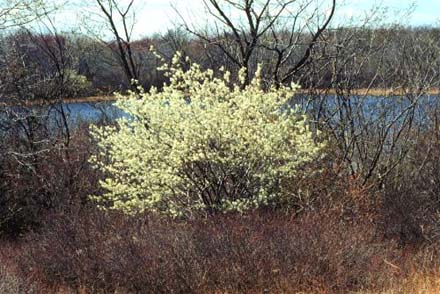
Springtime in the Mid Atlantic brings out the flowers and fragrances of blossoming trees and shrubs; and, if your knowledge of the landscape is high, the conundrum of the dangerous beauty of invasive species. Like roses in a corn field, purple loosestrife along streams and lionfish escaped from aquariums, the sweep of Callery pears (Pyrus calleryana), also know as Bradford pears, highlights the dichotomy between short term pleasure and long term cost throughout the woodlands of Maryland.
The seeming street and parking lot tree of choice is in full bloom competing with the Japanese cherries. The well-behaved cherries stay in place and are not seen in the woods and natural areas. The promiscuous pears produce hybrid off-spring that multiple unchecked on public and private lands creating a snow-like blanket of white along the roads and by-ways. The beauty is magnificent at a distance the smell up close is memorable; the damage to cars as limbs crash on roof tops is insurable.
 Like the rose in the garden, the Bradford pear is beautiful in bloom, but is otherwise a weed competing for scarce resources and lowering the the harvest yield. Gardeners are very aware that some plants run amok and need to be controlled, removed and not planted near the garden. The Bradford pear damages the yield (services) of the ecosystem in to which is spreads. The non native tree creates biological deserts or monocultures reducing the amount of diversity. The homogenization of the landscape destroys the sense of place special to each location.
Like the rose in the garden, the Bradford pear is beautiful in bloom, but is otherwise a weed competing for scarce resources and lowering the the harvest yield. Gardeners are very aware that some plants run amok and need to be controlled, removed and not planted near the garden. The Bradford pear damages the yield (services) of the ecosystem in to which is spreads. The non native tree creates biological deserts or monocultures reducing the amount of diversity. The homogenization of the landscape destroys the sense of place special to each location. Amelanchier laevis, Allegheny serviceberry, is a wonderful native that can replace the pear. Also in the same genus are several other serviceberries (shadbush, serviceberry, sarvisberry, juneberry, Saskatoon, shadblow, shadwood, sugarplum, and wild-plum) such as Amelanchier canadensis and Amelanchier x grandiflora.
Amelanchier laevis, Allegheny serviceberry, is a wonderful native that can replace the pear. Also in the same genus are several other serviceberries (shadbush, serviceberry, sarvisberry, juneberry, Saskatoon, shadblow, shadwood, sugarplum, and wild-plum) such as Amelanchier canadensis and Amelanchier x grandiflora. 
Another native worth considering in the landscape as an alternative to the ubiquitous pear is the green hawthorn (Crataegus viridis). Unlike the invasive pear, the hawthorn has four seasons of landscape ornamental interest from spring flowers, and summer foliage, to fall color and winter berries. The invasive Bradford pear hides its true destructive nature behind a fleeting spring display. As Vergil might have written: “Quidquid id est,  timeo Prunos et dona ferentis”
timeo Prunos et dona ferentis” 
 timeo Prunos et dona ferentis”
timeo Prunos et dona ferentis” 
No comments:
Post a Comment